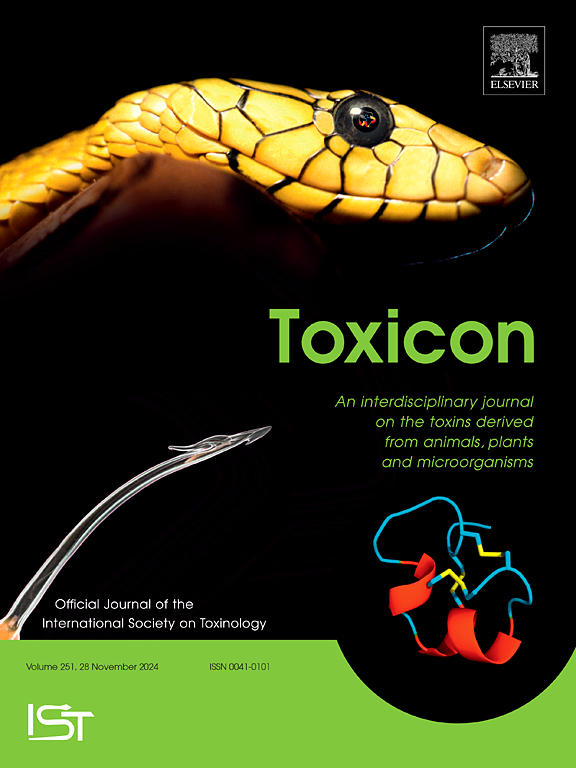韩国海产腹足动物关节炎海产和水母海产毒鼠胺含量的季节变化
IF 2.6
4区 医学
Q2 PHARMACOLOGY & PHARMACY
引用次数: 0
摘要
毒鼠胺是一种毒素,主要存在于海洋腹足类食肉动物的唾液腺中。韩国和日本等经常食用海洋腹足类动物的国家,每年仍有毒鼠胺中毒病例报告。因此,研究这些物种毒鼠胺含量的季节变化是至关重要的。在这项研究中,采用液相色谱-串联质谱(LC-MS /MS)分析了在韩国东海岸收集的一年中(2023年9月至2024年8月)关节炎海王星和eulimata海王星各组织中鼠胺含量的月度变化。计算了两种鱼类的条件指数,以估计它们的产卵季节。与其他组织(即足部和中肠腺)相比,在所有季节和物种的唾液腺中始终发现最高的毒鼠胺含量。毒虫胺含量在2023年11月达到峰值(关节炎乳螨为4580.05 mg/kg,真毛乳螨为7762.16 mg/kg), 2024年2月降至最低点(关节炎乳螨为568.10 mg/kg,真毛乳螨为679.35 mg/kg)。在产卵季节之后,增加的摄食活动可能导致毒鼠胺水平升高,可能有助于捕获猎物。因此,切除这些物种的唾液腺,特别是在11月,对于减轻毒鼠胺中毒的风险至关重要。本文章由计算机程序翻译,如有差异,请以英文原文为准。

Seasonal variation in tetramine content in Korean marine gastropods Neptunea arthritica and Neptunea eulimata
Tetramine is a toxin that is primarily found in the salivary glands of carnivorous marine gastropods. Countries, such as South Korea and Japan, where marine gastropods are commonly consumed, continue to report annual cases of tetramine poisoning. Therefore, it is crucial to investigate the seasonal variations in tetramine content in these species. In this study, liquid chromatography–tandem mass spectrometry (LC–MS/MS) was employed to analyze the monthly variations in tetramine content across various tissues of Neptunea arthritica and Neptunea eulimata collected over a one-year period (September 2023 to August 2024) from the East Coast of Korea. The condition indices of both species were calculated to estimate their spawning seasons. Compared to other tissues (i.e., the foot and midgut gland), the highest tetramine content was consistently found in the salivary glands across all seasons and species. The tetramine content in the salivary glands peaked in November 2023 (4580.05 mg/kg for N. arthritica and 7762.16 mg/kg for N. eulimata) and declined to the lowest value in February 2024 (568.10 mg/kg for N. arthritica and 679.35 mg/kg for N. eulimata). After the spawning season, the increased feeding activity may result in elevated tetramine levels, potentially contributing to prey capture. Therefore, removing the salivary glands of these species, particularly in November, is critical to mitigate the risk of tetramine poisoning.
求助全文
通过发布文献求助,成功后即可免费获取论文全文。
去求助
来源期刊

Toxicon
医学-毒理学
CiteScore
4.80
自引率
10.70%
发文量
358
审稿时长
68 days
期刊介绍:
Toxicon has an open access mirror Toxicon: X, sharing the same aims and scope, editorial team, submission system and rigorous peer review. An introductory offer Toxicon: X - full waiver of the Open Access fee.
Toxicon''s "aims and scope" are to publish:
-articles containing the results of original research on problems related to toxins derived from animals, plants and microorganisms
-papers on novel findings related to the chemical, pharmacological, toxicological, and immunological properties of natural toxins
-molecular biological studies of toxins and other genes from poisonous and venomous organisms that advance understanding of the role or function of toxins
-clinical observations on poisoning and envenoming where a new therapeutic principle has been proposed or a decidedly superior clinical result has been obtained.
-material on the use of toxins as tools in studying biological processes and material on subjects related to venom and antivenom problems.
-articles on the translational application of toxins, for example as drugs and insecticides
-epidemiological studies on envenoming or poisoning, so long as they highlight a previously unrecognised medical problem or provide insight into the prevention or medical treatment of envenoming or poisoning. Retrospective surveys of hospital records, especially those lacking species identification, will not be considered for publication. Properly designed prospective community-based surveys are strongly encouraged.
-articles describing well-known activities of venoms, such as antibacterial, anticancer, and analgesic activities of arachnid venoms, without any attempt to define the mechanism of action or purify the active component, will not be considered for publication in Toxicon.
-review articles on problems related to toxinology.
To encourage the exchange of ideas, sections of the journal may be devoted to Short Communications, Letters to the Editor and activities of the affiliated societies.
 求助内容:
求助内容: 应助结果提醒方式:
应助结果提醒方式:


